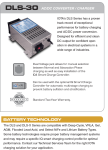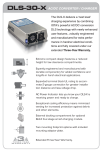Long winded reply here and this subject has been beaten to death but I've always found a lot of the information to be misleading. This is based on my research and experience so I could also be wrong but I'm fairly confident in the following information. If I'm incorrect, someone with more experience will correct me, I'm sure.
We use Noco chargers to keep camper batteries charged in our shop. Plenty of other battery charger manufacturers out there if you don't want a Noco. This simply charges the batteries, nothing more.
The higher the amperage the charger, the faster your batteries can be recharged. We use 5amp chargers to keep batteries topped off, 10amp chargers to charge batteries faster (and the provide some additional features over the 5a). Or, we use the larger pro series chargersfor battery repair, maintenance, charging, etc.
I'm assuming this is a shell, otherwise, you should have a shore power connection on the FWC line of full featured campers.
IOTA is what they use on their full featured campers, that come with shore power connections, but that's a different product in general. IOTA makes a 12v charger/power supply. Most battery chargers, like most Noco chargers, are not meant to be a true shore power/power supply.
The IOTA charger/power supply would need to be integrated into your camper's electrical system and a hole would need to be cut for an outlet pass through. This allows you to use the IOTA device to charge batteries, or, to use the device as a power supply, aka, shore power.
Explore IOTA's line of 12 VDC power converters and battery chargers today.

www.iotaengineering.com
You would need to select the correct IOTA charger, based on amperage, for your application. FWC uses as the DLS-30a/IQ4 charger with the built in IQ4 unit for multistage charging profiles. If anyone wants this unit, who plans on upgrading to lithium batteries down the road, get the DLS-30 with the IQ4 input plug. This allows the use to pick which IQ4 unit they need; AGM, lithium etc.
View attachment 748761
Looks like there's a new verion available,
View attachment 748762
There's a lot of misinformation out there when it comes to using a Noco charger as a shore power solution. On the smaller chargers, <5a, if the charger senses an outgoing load while the charger is attempting to apply current to the battery, it interprets this as a battery that is not holding a charge. We find our 5a chargers, connected to campers, in the fault mode when we're leaving lights on or running accessories in our showroom campers. The 10a Noco Genius can be set to "power supply" but if the load on your batteries exceeds 10a, I'd expect the charger to fault. The power supply mode on the 10a charger is really meant for their 12v outlet adapter, which can be plugged into the charger to run accessories off a 12v receptacle. As far as running it one power supply mode, while connected to batteries, with the intention of running your fridge, lights, fan and furnace, I do not believe it's meant to be used in that fashion.
Long story long, most off the shelf chargers are not designed to be power supplies. Some folks seem to be having luck using them in that fashion though. I'm considering buying a FWC Hawk Shell which does not offer shore power. If I were to integrate a charger/power supply, I'd use one designed for that application like the IOTA unit. If all I wanted to do was charge the batteries, just get a 10a Noco Genius and two days parked at the station should top them off. Remember, you're charging on your way home from a trip and one your way into the station. My assumption is the batteries should be showing up for your shift somewhat recharged. The Noco charger most likely doesn't need to charge your batteries from a 0% state of charge.
Side note because I touched on lithium compatibility and people are asking about that more and more frequently. If I were to go full lithium upgrade, with shore power, I'd go with a National Luna 40a DC-DC, upgrade the camper wiring to 4awg, push the FWC solar wiring to the built in solar controller in the DC40 and in the 3rd DC input on the charger, I'd use a 24v/25a Meanwell AC to DC converter wired to an external plug for shore power. The DC40 charger would take the DC current from the Meanwell converter and then apply the correct charging profile logic to the power provided through the 3rd DC unit.
MEAN WELL is one of the world's few standard power supply mainly professional manufacturers, covering 0.5 to 25,600W products are widely used in industrial control, medical and other fields, in line with international safety certification, short delivery of spot inventory.
www.meanwell.com
The NLDC-40 from National Luna is a DC to DC battery charger and isolator for a dual-battery system. It will charge an auxiliary or service battery from a vehicle alternator or Solar panel up to 40A output current. Traditional 12V and 24V vehicle alternators as well as variable voltage...

www.equipt1.com
Other folks might have different insights but that's what I've learned as a Four Wheel Camper dealer and doing my own research into my own camper purchase. Of course, plenty of other systems that can be integrated or configured, this is what I'm familiar with.
Best,





